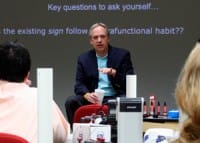
The State of Dentistry in 2019
Florida Association of General Dentistry (AGD) caught up with Clinical Director, Dr. John Cranham to talk about how to thrive as a dentist, the current ‘State of the Union’ in dentistry and a number of other hot topics. Check out how it went
1.) If you could do a “State of the Union” for dentistry, what would be your overall thoughts?
 It’s a very interesting question. On one hand, US News and World Report awarded General Dentistry the #2 job in America, and Orthodontist is #5. The respect of the profession is stronger than it has ever been.
It’s a very interesting question. On one hand, US News and World Report awarded General Dentistry the #2 job in America, and Orthodontist is #5. The respect of the profession is stronger than it has ever been.
Yet when I go around the country and talk to general practitioners, as well specialists (especially orthodontists), there is a perception that we are in the middle of a shift. In fact, some think it will forever change the life we have known as a dentists. The thinking is that we will be working more hours, for fewer dollars, and over time the respect for the profession will wain.
While I agree that there are some challenges for general dentists, there still are tremendous opportunities. Baby boomers are now aging and this is the first population of people who do not expect to lose their teeth. They are spending billions of dollars on appearance-related and health-related issues. We have better materials and lab support than any other time in history. Technology is allowing us to do things more efficiently and many times more accurately, increasing both quality and productivity.
So we are sitting in an interesting place. I do believe that this could be the best time ever to be a dentist. To do so, we are going to have to be exceptional. Usual and customary will not cut it. There are some specific things a dentist will need to do, in order to thrive during this time.
2.) What do you think the greatest challenge is for a young dentist leaving dental school today?

While many think this is what will be the demise of our profession, I believe that dentists can be successful in a variety of different environments. I have practiced as a solo practitioner, in a multi-doctor, multi-location group practice and now in a DSMO. What I have always focused on is making sure NOTHING gets in the way of how I diagnose, treatment plan, and schedule. If the doctor has the ability to control those things they can stay on a path towards being exceptional.
3.) Do you think the “pressure” on a general practice is different than it was a decade ago?
I think there are some similarities, but I also think there are some differences. The third-party payer issue with dental insurance is still there and can make it difficult to stay profitable. For the solo practicing doctor, there are larger group practices, and corporate entities that are becoming more common, putting pressure on the little guy. The larger organizations have bigger marketing budgets, better abilities to negotiate for equipment and supplies (lower overhead), and can often put their offices in more visible locations.
Additionally, we are seeing products and services going directly to the consumer. Clear aligner therapy can be done by mail, or you can go to a “store” in a mall and be scanned. Either way, the aligners are sent to them directly to the consumer without the supervision of a dentist. The point is, when a patient is considering where they will go for the services they want, the choices are far greater.
The dentist today, has to think very clearly about how they are going to differentiate themselves in today’s economic landscape. What excites me is I think it’s possible to stand out in a way that you can not only be busy, but do more of the procedures you truly love to do.
4.) As an educator, are there things you are doing differently to meet the needs of today’s dentist?
![]() What I notice the most today is that dentists want to have access to information in a variety of formats. When I left dental school in 1988, we pretty much had books, lectures and the occasional VHS tape we could watch. But we went to lectures at big meetings, local events or at teaching institutions around the country.
What I notice the most today is that dentists want to have access to information in a variety of formats. When I left dental school in 1988, we pretty much had books, lectures and the occasional VHS tape we could watch. But we went to lectures at big meetings, local events or at teaching institutions around the country.
The internet changed all of that. Dentists have access to chat rooms, online forums, YouTube, as well as online options they can pay for.
I believe online messaging has changed the pace at which people want information. We have had to adjust by getting our own messaging tighter and to the point. It doesn’t matter if we are doing a lecture in a hotel room, a hands-on training session or something online, at The Dawson Academy, we have recognized that people don’t want fluff. I am not suggesting that we had a lot of fluff before, but we have really boiled down our content to really get clear on what the student will need to have success back in their offices. This is probably the largest change over the last decade.
The only other thing that has really improved our ability to teach is the ease at which we can obtain clinical photography, as well as a great video to input into our programs. High-resolution, digital photography and videography have been a tremendous aid in helping us show other colleagues what we do and how to do it.
5.) What do you think a dentist has to do today to thrive in these economic times?

- As a dentist what are you deeply passionate about (what do you love doing)?
- What could you be best in the world at (what could you do as well as anybody)?
- What fuels your economic engine (what procedures are the most profitable)?
If you can focus on the things in your practice that have all of those qualities you are going to THRIVE as a dentist. The reason for this is the vast majority of the dental world is literally running towards usual and customary. Trying to figure out how they can do things faster, get compensated by third parties, and do as much of it as they possibly can. While I believe you can be very successful doing it this way, it is difficult to sustain and it is exhausting.
The other way is to become exceptional in an area of dentistry that will allow you to solve problems most people can’t. That may be related to esthetics, replacing teeth with implants, solving TMJ problems or restoring broken down occlusions. Jim Collins points out if you LOVE what you’re doing, great at it, and are charging appropriately it will translate to success. The kicker is if it were easy, everyone would be doing this.
Dentists that take this route are going to have to invest both time and money to get trained to practice at this level, as well as learn the business, leadership and communication skills that are as important as the clinical excellence. They are also going to have to learn to professionally get the word out on how they are different.
The good news, is today’s consumers are highly educated. Many patients are acutely aware that there is a difference between usual and customary, and someone who has separated themselves from the pack. They will search the internet, talk to their community, sometimes interview multiple healthcare providers until they find the person they believe will solve their problem
So the short answer to this question is the doctor first has to have the courage to set a bold vision, what Collins called a BHAG (Big Hairy Audacious Goal). They need to ask and answer those three questions. Then they have to work at it. The great thing about being a dentist is we have the capacity to always learn new things, reinvent ourselves, and continuously improve. For those that do that, they will not only experience the spiritual rewards of helping people, but they will also live the life as a dentist that they dreamt of.
Start your journey to becoming an Exceptional Dentist by joining Dr. Cranham at Functional Occlusion – From TMJ to Smile Design (Seminar 1).









Leave a Reply
Want to join the discussion?Feel free to contribute!